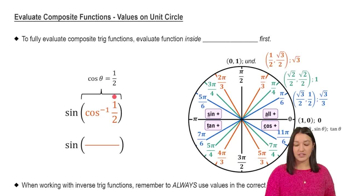Table of contents
- 0. Functions7h 52m
- Introduction to Functions16m
- Piecewise Functions10m
- Properties of Functions9m
- Common Functions1h 8m
- Transformations5m
- Combining Functions27m
- Exponent rules32m
- Exponential Functions28m
- Logarithmic Functions24m
- Properties of Logarithms34m
- Exponential & Logarithmic Equations35m
- Introduction to Trigonometric Functions38m
- Graphs of Trigonometric Functions44m
- Trigonometric Identities47m
- Inverse Trigonometric Functions48m
- 1. Limits and Continuity2h 2m
- 2. Intro to Derivatives1h 33m
- 3. Techniques of Differentiation3h 18m
- 4. Applications of Derivatives2h 38m
- 5. Graphical Applications of Derivatives6h 2m
- 6. Derivatives of Inverse, Exponential, & Logarithmic Functions2h 37m
- 7. Antiderivatives & Indefinite Integrals1h 26m
- 8. Definite Integrals4h 44m
- 9. Graphical Applications of Integrals2h 27m
- 10. Physics Applications of Integrals 2h 22m
4. Applications of Derivatives
Differentials
Problem 25
Textbook Question
As a result of a heavy rain, the volume of water in a reservoir increased by 1400 acre-ft in 24 hours. Show that at some instant during that period the reservoir’s volume was increasing at a rate in excess of 225,000 gal/min. (An acre-foot is 43,560 ft³, the volume that would cover 1 acre to the depth of 1 ft. A cubic foot holds 7.48 gal.)
 Verified step by step guidance
Verified step by step guidance1
First, convert the total increase in volume from acre-feet to gallons. Since 1 acre-foot is 43,560 cubic feet and 1 cubic foot holds 7.48 gallons, multiply 1400 acre-feet by 43,560 to get the volume in cubic feet, and then multiply by 7.48 to convert to gallons.
Next, calculate the average rate of increase in gallons per minute over the 24-hour period. There are 24 hours in a day and 60 minutes in an hour, so multiply 24 by 60 to find the total number of minutes in the period.
Divide the total increase in gallons by the total number of minutes to find the average rate of increase in gallons per minute.
Apply the Mean Value Theorem for derivatives, which states that if a function is continuous on a closed interval and differentiable on the open interval, then there exists at least one point in the interval where the instantaneous rate of change (derivative) equals the average rate of change over the interval.
Since the average rate of increase is less than 225,000 gal/min, and the total increase is 1400 acre-ft, use the Mean Value Theorem to conclude that there must be at least one instant during the 24-hour period where the rate of increase exceeded 225,000 gal/min.
 Verified video answer for a similar problem:
Verified video answer for a similar problem:This video solution was recommended by our tutors as helpful for the problem above
Video duration:
5mPlay a video:
Was this helpful?
Key Concepts
Here are the essential concepts you must grasp in order to answer the question correctly.
Rate of Change
In calculus, the rate of change refers to how a quantity changes over time. It is often represented as a derivative, which measures the instantaneous rate of change of a function. In this context, we are interested in how the volume of water in the reservoir changes with respect to time, specifically looking for the maximum rate of increase during the 24-hour period.
Recommended video:

Intro To Related Rates
Mean Value Theorem
The Mean Value Theorem states that if a function is continuous on a closed interval and differentiable on the open interval, there exists at least one point where the instantaneous rate of change (derivative) equals the average rate of change over that interval. This theorem is crucial for this problem as it allows us to conclude that there must be a moment when the volume increase exceeds the average rate calculated over the 24 hours.
Recommended video:

Fundamental Theorem of Calculus Part 1
Unit Conversion
Unit conversion is the process of converting a quantity expressed in one set of units to another. In this problem, we need to convert the increase in volume from acre-feet to gallons per minute to compare it with the required rate. Understanding how to convert between these units is essential for accurately determining whether the instantaneous rate exceeds 225,000 gallons per minute.
Recommended video:

Evaluate Composite Functions - Values on Unit Circle







